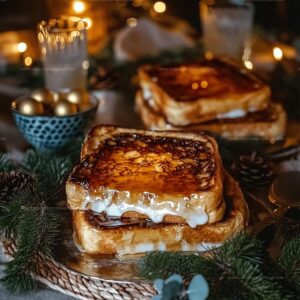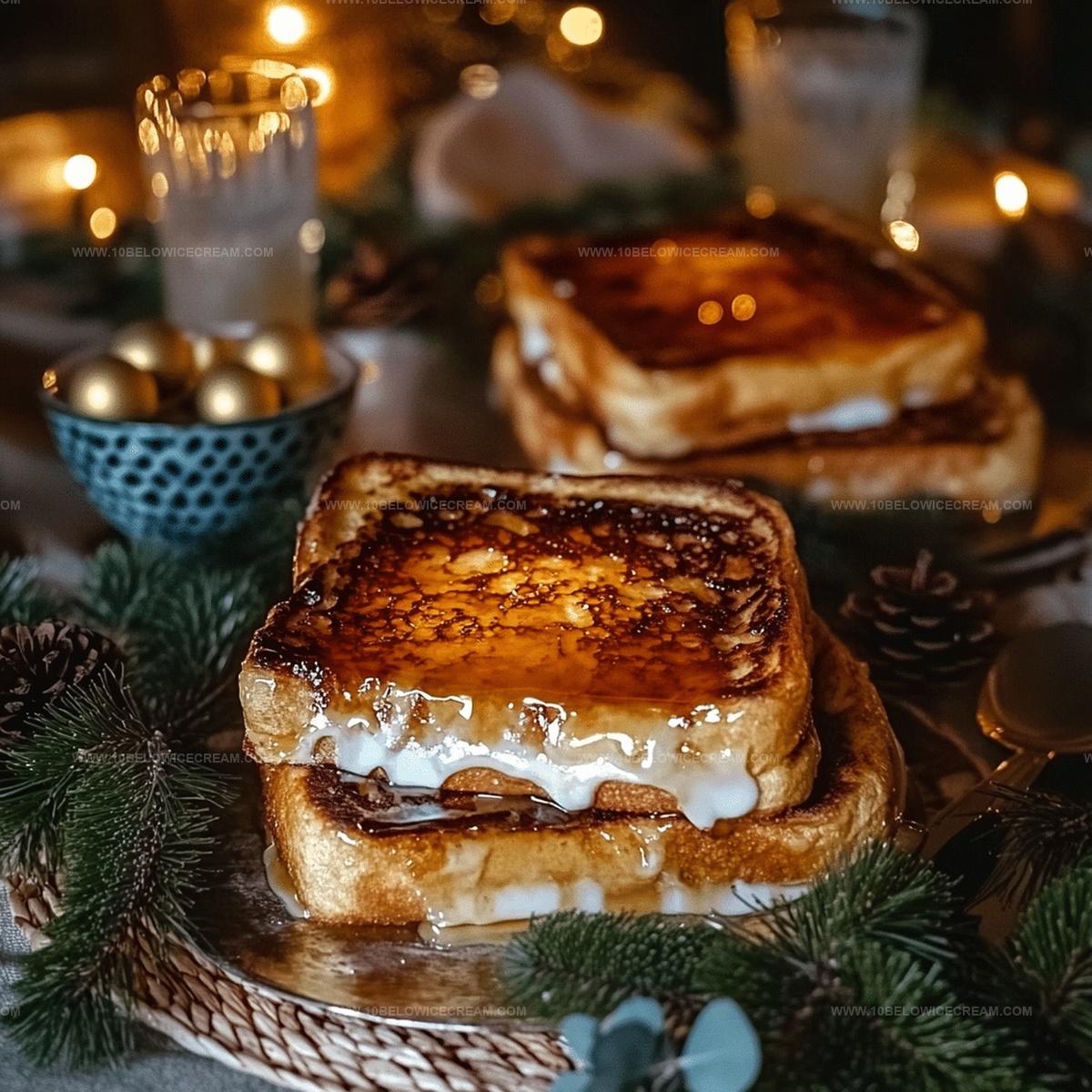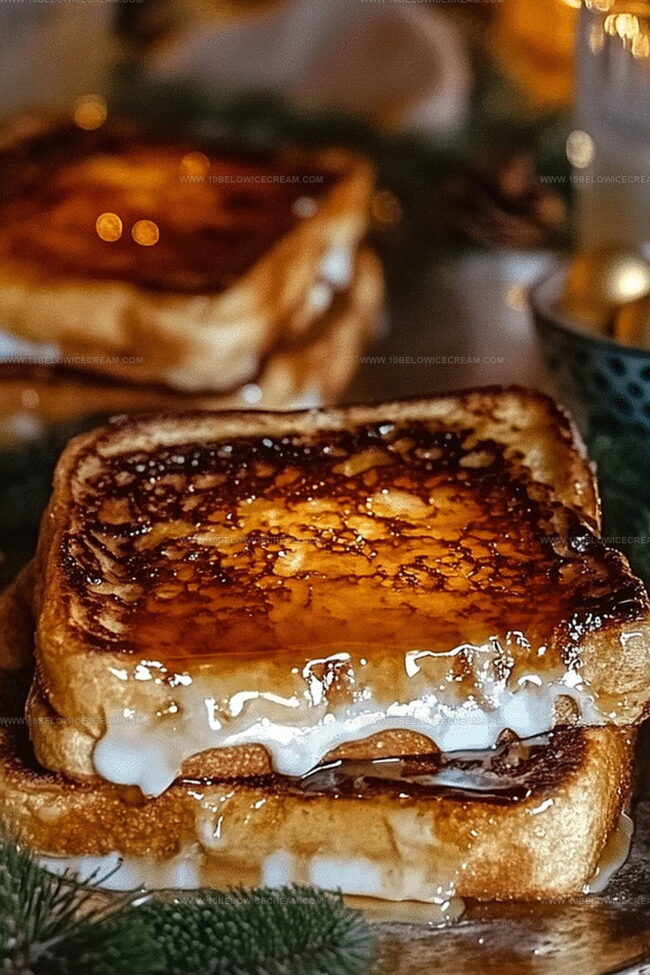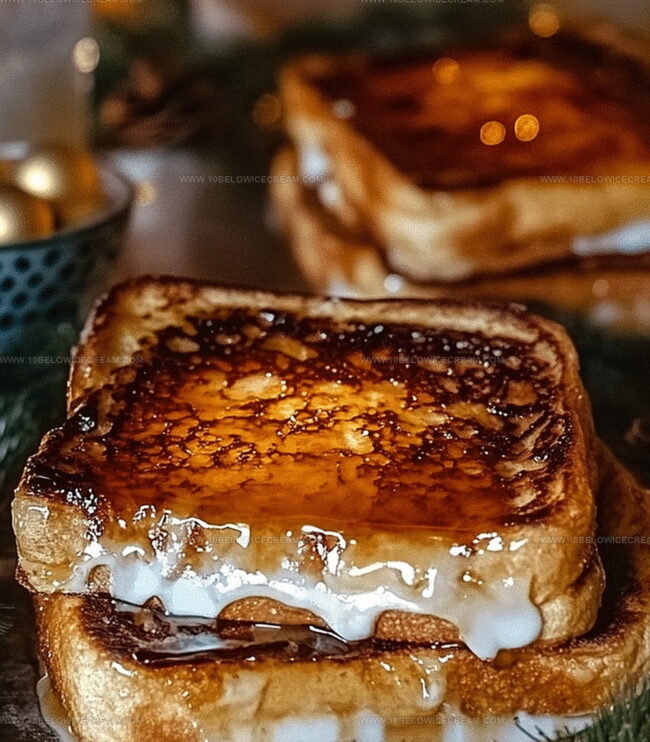Overnight Creme Brulee French Toast Recipe to Make
Crafting a delectable overnight creme brulee french toast brings pure breakfast magic to your morning table.
Soft, custard-soaked bread transforms into a decadent dish that feels like dessert for your first meal.
Layers of rich flavor promise a stunning centerpiece for weekend gatherings.
Vanilla and caramelized sugar create an irresistible combination that will make you the star of any brunch.
Minimal prep work means you can assemble everything the night before, letting ingredients meld together beautifully.
Minimal morning effort yields maximum deliciousness with this crowd-pleasing recipe.
Your guests will be asking for seconds before the first bite is finished.
What Makes Overnight Creme Brulee French Toast Special
What Goes Into Overnight Creme Brulee French Toast
For the Bread:For the Liquid Base:For the Sweeteners and Flavors:For the Topping and Finishing:Easy Method For Overnight Creme Brulee French Toast
Step 1: Slice French Bread Into Thick Pieces
Cut the French bread into substantial 1-inch thick slices that will provide a robust base for the french toast casserole. Each slice should be hearty and ready to soak up the delicious custard mixture.
Step 2: Create Creamy Custard Mixture
In a large mixing bowl, whisk together:Blend until the mixture becomes silky and completely smooth, creating a rich foundation for the dish.
Step 3: Add Flavor Enhancers
Incorporate the following ingredients into the liquid mixture:Stir thoroughly until all components are fully integrated and the blend appears uniform and aromatic.
Step 4: Layer Bread in Baking Dish
Generously butter a baking dish and arrange the bread slices in a single compact layer. Ensure the slices are closely packed without significant gaps, creating a solid base for the casserole.
Step 5: Saturate Bread With Custard
Pour the prepared custard mixture over the bread slices. Gently ensure each piece is completely saturated, allowing the bread to absorb the liquid evenly and thoroughly.
Step 6: Refrigerate Overnight
Cover the baking dish with plastic wrap and refrigerate for the entire night. This extended soaking time allows the bread to develop deep, rich flavors and absorb the custard completely.
Step 7: Bring to Room Temperature
Remove the casserole from the refrigerator 30 minutes before baking. Let it sit at room temperature to ensure even cooking.
Step 8: Prepare for Baking
Preheat the oven to 350°F and uncover the dish. Drizzle melted butter and maple syrup across the top of the soaked bread, adding an extra layer of flavor and richness.
Step 9: Bake to Golden Perfection
Bake the casserole for 45-50 minutes. Look for golden brown edges and a center that appears set and slightly puffy, indicating it’s perfectly cooked.
Step 10: Create Caramelized Topping
Sprinkle turbinado sugar evenly across the surface of the baked casserole. Use a kitchen torch to caramelize the sugar until it transforms into a crisp, amber-colored crust. Alternatively, carefully broil for 2-3 minutes, watching closely to prevent burning.
Step 11: Rest and Serve
Allow the casserole to rest for 5-10 minutes before serving. This brief waiting period helps the caramelized topping solidify and allows the dish to set, ensuring the perfect texture and presentation.
Helpful Tips For Overnight Creme Brulee French Toast
Creative Styles For Overnight Creme Brulee French Toast
Perfect Pairings For Overnight Creme Brulee French Toast
How To Store Overnight Creme Brulee French Toast Right
Overnight Creme Brulee French Toast FAQ Section
Thick 1-inch bread slices provide better absorption of the custard mixture and create a more substantial, rich texture for your French toast bake.
Yes, refrigerating overnight allows bread to fully soak up the custard, developing deeper, more complex flavors and ensuring a consistently moist result.
Turbinado sugar creates a delightful caramelized crust with a slight crunch, adding a beautiful golden top and extra layer of sweetness to the French toast bake.
No, you can alternatively use your oven’s broiler for 2-3 minutes to achieve a similar caramelized effect, just watch carefully to prevent burning.
Print
Overnight Creme Brulee French Toast Recipe
- Total Time: 1 hour 20 minutes
- Yield: 6 1x
Description
Sumptuous Overnight Creme Brulee French Toast brings classic French elegance to weekend breakfast dreams. Silky custard-soaked bread caramelizes with golden richness, promising pure indulgence you’ll savor down to the last delectable bite.
Ingredients
Main Ingredients:
- 1 loaf French bread
- 6 large eggs
- 2 cups whole milk
- 1 cup heavy cream
Sweeteners and Flavors:
- 1/2 cup granulated sugar
- 1/4 cup brown sugar
- 2 tsp vanilla extract
- 1 tsp ground cinnamon
Toppings and Finishing:
- 1/4 cup unsalted butter
- 1/4 cup maple syrup
- 2 tbsp turbinado sugar (for brulee topping)
- 1 pinch salt
Instructions
- Slice the French bread into thick, robust pieces, ensuring each slice is approximately 1-inch thick for substantial texture and optimal absorption.
- Whisk eggs, whole milk, and heavy cream in a large mixing bowl until thoroughly combined and silky smooth.
- Incorporate granulated sugar, brown sugar, vanilla extract, cinnamon, and salt into the liquid mixture, stirring until all ingredients are completely integrated and the blend appears uniform.
- Arrange bread slices in a generously buttered baking dish, creating a single compact layer without significant gaps.
- Gently pour the custard mixture over the bread, ensuring each slice is completely saturated and absorbing the liquid evenly.
- Cover the baking dish with plastic wrap and refrigerate overnight, allowing the bread to fully soak and develop deep, rich flavors.
- Remove from refrigerator 30 minutes before baking to bring to room temperature.
- Preheat oven to 350°F and uncover the dish.
- Drizzle melted butter and maple syrup across the top of the soaked bread.
- Bake for 45-50 minutes until the edges turn golden brown and the center appears set and slightly puffy.
- Sprinkle turbinado sugar evenly across the surface.
- Use a kitchen torch to caramelize the sugar until it transforms into a crisp, amber-colored crust, or broil for 2-3 minutes watching carefully to prevent burning.
- Let rest for 5-10 minutes before serving to allow the caramelized topping to solidify and the dish to set.
Notes
- Select day-old bread for better absorption and preventing soggy texture during overnight soaking.
- Choose thick-cut French bread or brioche to maintain structural integrity and provide rich, luxurious mouthfeel.
- Customize flavor profile by experimenting with alternative spices like nutmeg or cardamom for subtle complexity.
- Make gluten-free version by substituting regular bread with gluten-free challah or thick-cut gluten-free bread slices.
- Reduce sugar content by using monk fruit sweetener or replacing some granulated sugar with stevia for lighter option.
- Enhance protein content by incorporating almond flour or adding a scoop of vanilla protein powder to custard mixture.
- Prepare ahead by assembling dish up to 48 hours in advance, maximizing convenience for special breakfast gatherings.
- Prep Time: 30 minutes
- Cook Time: 45-50 minutes
- Category: Breakfast, Desserts
- Method: Baking
- Cuisine: American
Nutrition
- Serving Size: 6
- Calories: 579
- Sugar: 30 g
- Sodium: 305 mg
- Fat: 32 g
- Saturated Fat: 19 g
- Unsaturated Fat: 9 g
- Trans Fat: 0 g
- Carbohydrates: 53 g
- Fiber: 2 g
- Protein: 12 g
- Cholesterol: 210 mg




Jackson Reid
Founder & Recipe Developer
Expertise
Education
Holyoke Community College – HCC-MGM Culinary Arts Institute
Certificate in Culinary Arts
Focus: Farm-to-table cuisine, sustainable cooking practices, and hands-on kitchen training
Jackson’s love for cooking began one dish at a time. After earning his Culinary Arts Certificate from Holyoke Community College’s HCC-MGM Culinary Arts Institute, he focused on what mattered most: creating recipes that are simple to follow and full of flavor.
At 10 Below Ice Cream, Jackson brings together global influences and a less-is-more approach. His recipes reflect his belief that good food doesn’t need to be complicated; it just needs to make sense, taste great, and feel right.
When he’s not testing ingredients or adjusting seasonings, you’ll find him hiking near Asheville, exploring local markets, or chasing the best light for food photos.